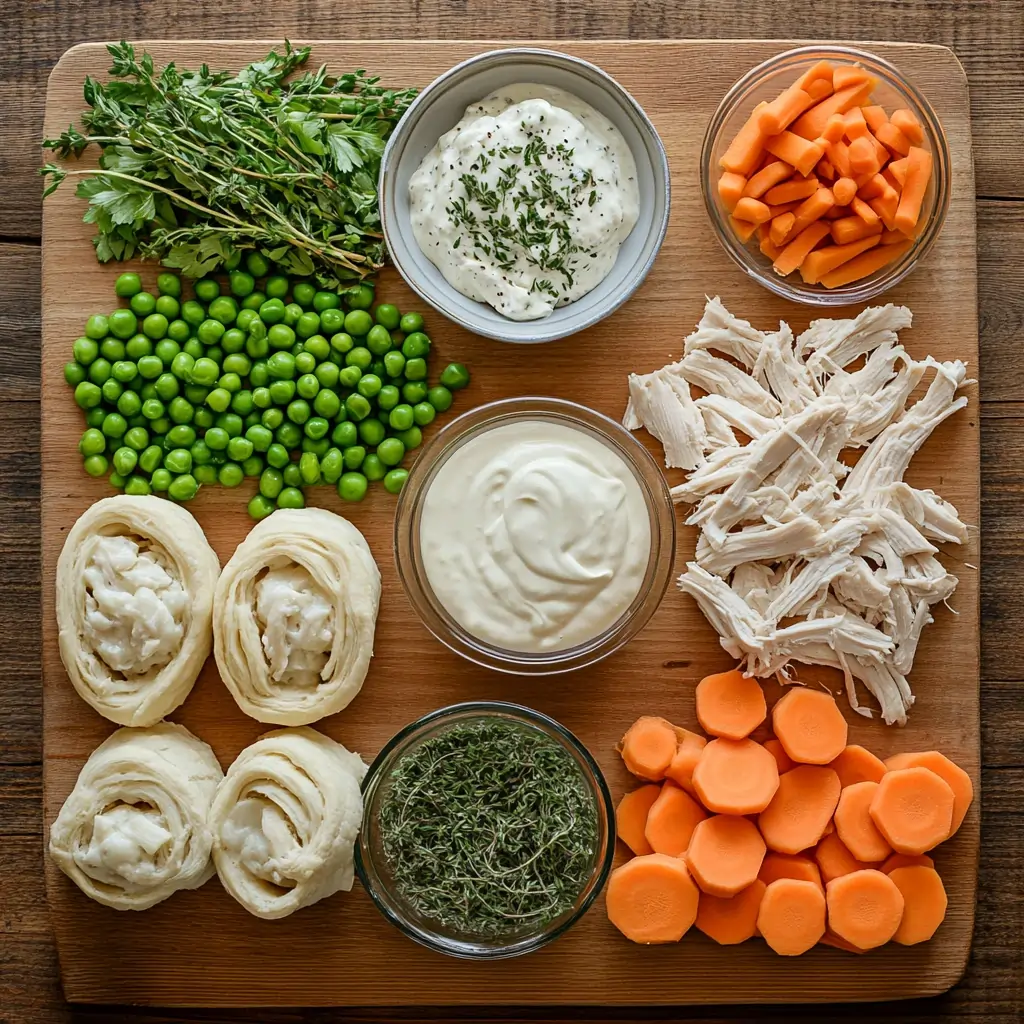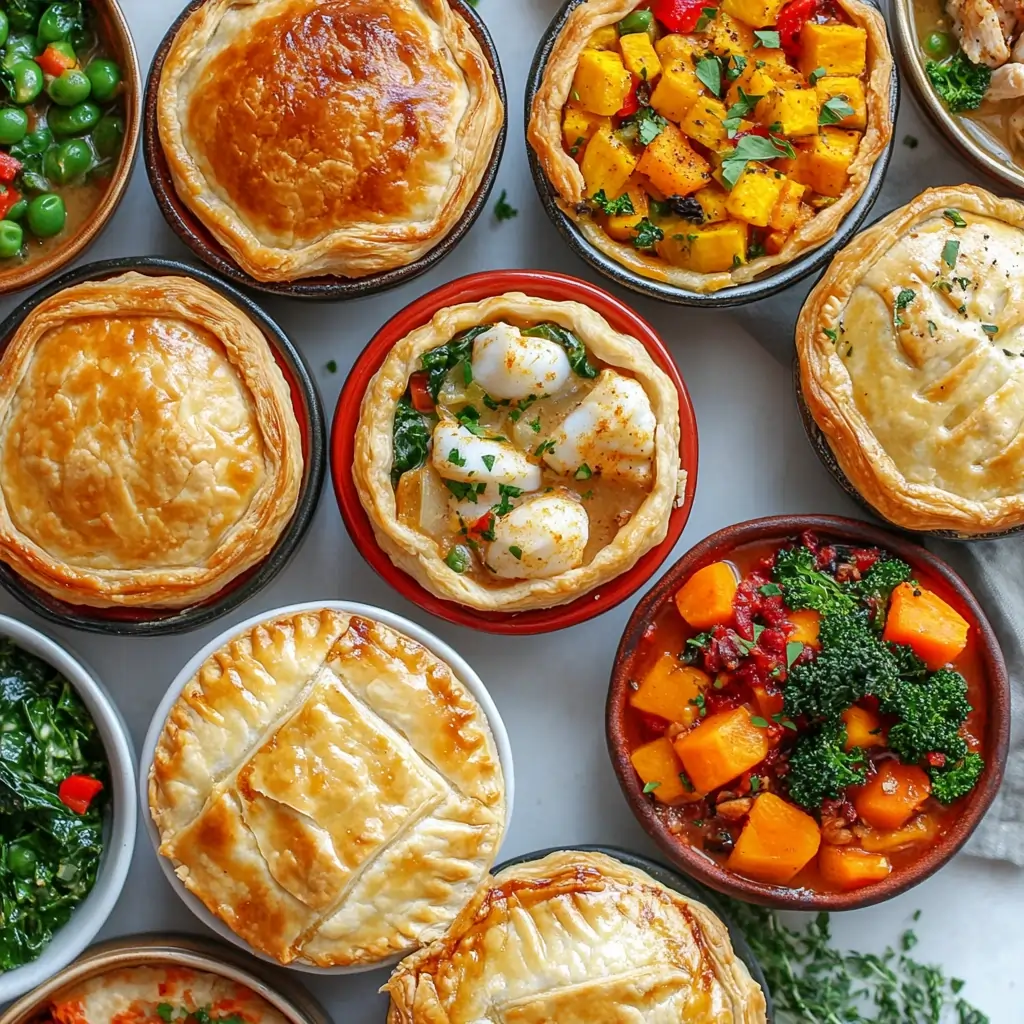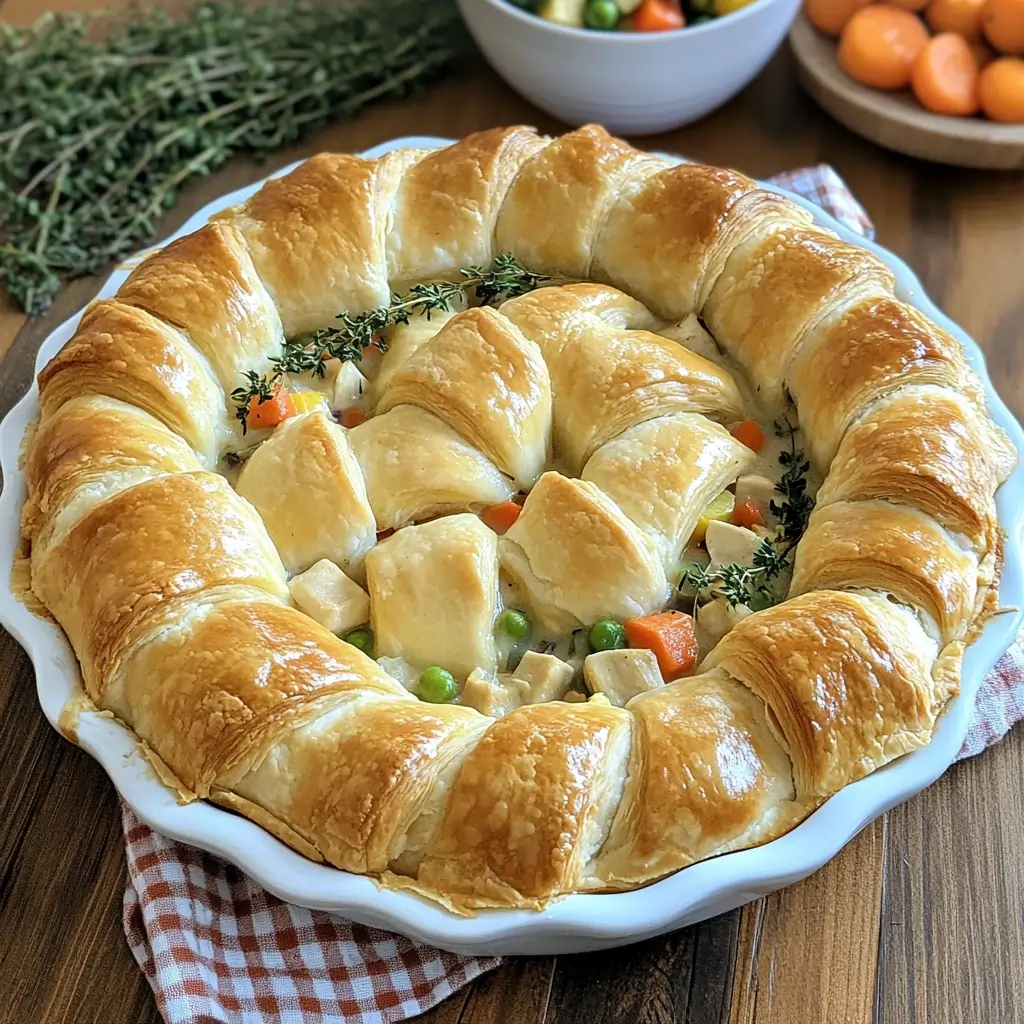Chicken pot pie with Crescent Rolls is a favorite comfort food. it’s known for its creamy filling and crispy crust. This version gives it a fresh twist by using crescent rolls instead of traditional pie crust. The crescent rolls are soft, buttery, and easy to use, making this recipe simple and quick. It is perfect for busy evenings or casual meals. This dish brings the warmth of a classic while adding a modern touch. Everyone at the table is sure to love it.
Comfort food makes us feel happy and cozy. Chicken pot pie is a great example with its creamy filling and flaky crust. This recipe uses crescent rolls to make the dish easier and tastier. The rolls add a fluffy and buttery texture that pairs well with the filling. It is a fun new way to enjoy an old favorite.
Table of Contents
1. Why Crescent Rolls Make This Recipe Unique
Crescent rolls make this dish stand out. They are quick to use, saving you time in the kitchen. When baked, they turn golden and flaky, adding a special texture. Their buttery flavor blends perfectly with the creamy filling. Crescent rolls bring a modern twist to the recipe, making it simple but delicious.
This Chicken Pot Pie with Crescent Rolls is easy and tasty. It has tender chicken, colorful vegetables, and a creamy sauce. The crescent rolls make it fluffy and golden. This dish is great for weeknights or gatherings. It combines the comfort of a classic with the ease of modern cooking.
2. Ingredients for Chicken Pot Pie with Crescent Rolls
Core Ingredients for the Best Chicken Pot Pie

The heart of this dish lies in its simple, flavorful ingredients.
- Use chicken that suits your needs—freshly cooked, rotisserie, or even leftovers.
- For vegetables, peas, carrots, and celery create a classic and colorful mix.
- The creamy sauce ties everything together with its rich and comforting flavor. It is the perfect base for the filling, making the pie satisfying and delicious.
These core ingredients are easy to find and combine for a meal that feels homemade with minimal effort.
The Role of Crescent Rolls in Chicken Pot Pie
Crescent rolls are the star of this recipe. They create a flaky, golden crust that is quick and easy to prepare. Their buttery flavor enhances the creamy filling, making every bite irresistible. Store-bought rolls are convenient, but you can also make your own if you prefer. To ensure the best results, handle the dough gently and keep it cool until ready to use. Crescent rolls simplify the process while adding a fresh twist to this classic dish.
Optional Additions and Substitutions
This recipe can be easily customized to suit different diets.
- For a vegetarian version, swap the chicken for tofu or mushrooms.
- If you need a dairy-free option, use coconut cream or a plant-based alternative in the sauce.
- Gluten-free crescent rolls are available at many stores or can be made at home. These options let you adapt the dish without losing its comforting and delicious qualities.
3. Step-by-Step Preparation of Chicken Pot Pie with Crescent Rolls
Preparing the Filling
- Start by cooking the chicken. You can boil or bake fresh chicken until tender, then shred it with forks for even pieces. Rotisserie chicken or leftovers also work well. For the vegetables, sauté peas, carrots, and celery in a bit of oil or butter until slightly softened. This step enhances their flavor and ensures they cook evenly in the pie.
- Next, make the creamy sauce. Combine chicken broth and flour in a pan, stirring until it thickens. Add a splash of cream for richness, and season with salt, pepper, and your favorite herbs.
- Mix the chicken and vegetables into the sauce to complete the filling.
Assembling the Perfect Chicken Pot Pie with Crescent Rolls
- Unroll the crescent rolls and arrange them at the base of your baking dish, pressing the seams together to form a crust.
- Pour the chicken and vegetable filling evenly over the dough. Lay another layer of crescent rolls on top, sealing the edges as best you can for a cohesive crust.
- Make small slits in the dough to allow steam to escape during baking. The top layer of crescent rolls will become golden and flaky, creating a perfect crust that contrasts beautifully with the creamy filling.
Final Touches Before Baking
- Brush the top layer of crescent rolls with an egg wash to give it a glossy, golden finish.
- For added flavor, sprinkle some shredded cheese or dried herbs over the crust. Make sure the dish is prepped evenly to ensure it bakes properly.
- Place it in a preheated oven, and your Chicken Pot Pie with Crescent Rolls will be ready to enjoy in no time!
4. Baking Tips for Success with Crescent Roll Pot Pie
4.1. Achieving the Perfect Bake
To get the best results, preheat your oven to 375°F (190°C). This is the ideal temperature for evenly baking the crescent rolls while heating the filling thoroughly. Bake the pot pie for about 25–30 minutes, or until the top crust is golden brown and flaky.
To avoid undercooked rolls, ensure the top layer is not too thick, as it may bake unevenly. If the edges of the rolls brown too quickly, cover them loosely with aluminum foil during the last 10 minutes of baking. On the other hand, avoid overbaking by checking the crust frequently after the 20-minute mark.
Keep an eye on the crust throughout the process. Look for a golden color and puffed texture as signs it’s done. If you’re unsure, insert a knife or toothpick into the center to confirm the filling is hot and bubbly.
4.2. Common Mistakes to Avoid
To prevent soggy bottoms, make sure the filling is not overly runny. A thick sauce ensures the crust stays firm. Also, preheating the oven is crucial to start baking the bottom layer immediately. Burnt edges can be avoided by covering them with foil if they brown too quickly. Finally, balance the filling-to-crust ratio by not overstuffing the pie. Too much filling can spill over and prevent the crust from baking evenly. Aim for a smooth, even layer of filling for the best results.
4.3. Troubleshooting Tips
If the filling is too runny, mix in a bit of cornstarch or flour while heating it to thicken. For undercooked crescent rolls, cover the pie with foil and bake for a few extra minutes. This helps the rolls cook through without burning the top. If baking is uneven, rotate the dish halfway through cooking to ensure all sides are exposed to equal heat. These tips will save your pot pie!
5. Variations and Creative Twists
5.1. Protein Alternatives
- Turkey: Swap out chicken for turkey to give your pot pie a Thanksgiving-inspired flair. This works especially well with leftover turkey from holiday dinners, adding a rich and hearty flavor.
- Seafood: Create a luxurious twist by incorporating cooked shrimp or crab meat. These proteins bring a delicate sweetness that pairs beautifully with the creamy filling. Ensure the seafood is cooked beforehand to avoid overcooking during baking.
- Plant-Based: Lentils are an excellent vegetarian substitute. They provide a meaty texture and absorb the flavors of the creamy sauce perfectly. For added taste, season lentils with smoked paprika or a dash of soy sauce before mixing them in.
“If you’re looking to branch out with different proteins, our guide on Keto Chicken Breast Recipes offers innovative low-carb alternatives to incorporate into your meal planning.”

5.2. Vegetable-Forward Variations
- Greens: Add fresh spinach or chopped kale to the filling. These greens wilt quickly, making them easy to incorporate without pre-cooking. They add nutrients, color, and a slight earthy flavor to the dish.
- Sweet Potatoes: Roasted sweet potatoes add a natural sweetness and creamy texture to the pot pie. Dice them into bite-sized cubes and roast them beforehand for maximum flavor.
- Frozen Mixed Vegetables: For convenience, use a frozen mix of peas, carrots, corn, and green beans. They require no prep and blend seamlessly with the filling, making them ideal for busy weeknights.
5.3. Spice and Flavor Enhancements
- Seasonings: Boost the sauce’s flavor with garlic or onion powder. These seasonings add depth without overpowering the dish and complement the creaminess beautifully.
- Herbs: Fresh or dried thyme and rosemary can elevate the overall taste. Sprinkle these herbs into the sauce or directly onto the filling for a fragrant, savory aroma.
- Heat: For those who love spice, add chili flakes or paprika to the sauce or sprinkle it over the top crust. The subtle kick balances the creamy filling and adds excitement to every bite.
6. Serving Suggestions and Leftovers for Chicken Pot Pie with Crescent Rolls
Best Side Dishes for Chicken Pot Pie
- Fresh Garden Salad: A light salad with crisp lettuce, tomatoes, cucumbers, and a tangy vinaigrette balances the richness of the pot pie.
- Mashed Potatoes: Creamy mashed potatoes make a hearty side that complements the flavors of the filling.
- Garlic Bread: Warm, crusty garlic bread is perfect for dipping into the creamy sauce, adding a touch of indulgence to the meal.
Presentation Tips
- Rustic Plating: Serve the pot pie directly from a cast-iron skillet or a rustic ceramic dish for a homestyle feel.
- Fresh Herb Garnish: Sprinkle chopped parsley, thyme, or rosemary over the top crust for a pop of color and freshness.
- Individual Ramekins: For parties or special occasions, bake the pot pie in individual ramekins. It adds a touch of elegance and ensures everyone gets their own serving.
Storage and Reheating
- Refrigeration: Store leftovers in an airtight container in the fridge for up to three days. Keep the crust separate if possible to maintain its texture.
- Reheating: Warm leftovers in the oven at 350°F (175°C) to re-crisp the crust. Avoid microwaving, as it can make the crust soggy.
- Freezing: Freeze the unbaked or baked pot pie in a freezer-safe dish. For best results, thaw overnight in the fridge and bake or reheat as needed.
“If you’re into make-ahead recipes, check out our tips in Slow Cooker Creamy Chicken Pasta for other time-saving comfort food ideas.”
7. FAQs About: Chicken Pot Pie with Crescent Rolls
What makes crescent rolls a good crust for pot pie?
Crescent rolls are an excellent choice for pot pie because they are buttery, flaky, and easy to use. Unlike traditional pie crusts, they require minimal prep work and bake quickly. Their light texture pairs perfectly with the creamy filling, creating a delicious contrast. Additionally, crescent rolls are versatile and can be shaped to fit any baking dish, making them a convenient option for this recipe.
Can I prepare this dish ahead of time?
Yes, you can prepare the pot pie in advance. Assemble the filling and layer it with the crescent rolls, then cover and refrigerate for up to 24 hours before baking. If making it even earlier, freeze the unbaked pot pie for up to two months. When ready to serve, thaw it overnight in the refrigerator and bake as directed. Preparing ahead saves time and makes it perfect for busy schedules.
What is the origin of pot pie?
Pot pie has origins in European cuisine, with early versions dating back to Roman times. It became popular in England and later in colonial America as a practical way to use leftover meat and vegetables. Traditional pot pies were made with a thick pastry crust and a hearty filling of meat, vegetables, and gravy. Over time, the dish evolved, and modern variations like this crescent roll version bring a fresh twist to the classic.
How do I make this gluten-free or dairy-free?
To make the dish gluten-free, use gluten-free crescent rolls and a gluten-free flour blend to thicken the sauce. For a dairy-free version, replace the cream with coconut milk or a plant-based alternative, and use a dairy-free butter substitute. These simple swaps allow you to enjoy the dish while accommodating dietary restrictions.
What are the best vegetables to include?
Classic vegetables like peas, carrots, and celery are perfect for pot pie. For added variety, try mushrooms, green beans, or corn. Seasonal vegetables like zucchini or butternut squash can also be great additions. Frozen mixed vegetables are a quick and convenient option. Choose veggies that provide a balance of flavors and textures for the best results.
8. Conclusion: Irresistible Chicken Pot Pie with Crescent Rolls
Chicken Pot Pie with Crescent Rolls is a delightful twist on a classic favorite. Its buttery, flaky crust, paired with a rich and creamy filling, makes it a comforting dish that’s both easy to prepare and incredibly satisfying. Whether you’re cooking for a busy weeknight or a special occasion, this recipe offers flexibility and flavor in every bite.
Feel free to make it your own by trying different proteins, vegetables, or spices. The possibilities are endless, and your creativity can turn this dish into a new family tradition.
We’d love to hear about your experience! Share your variations, tips, or favorite moments with this recipe—we can’t wait to see how you make it special.

